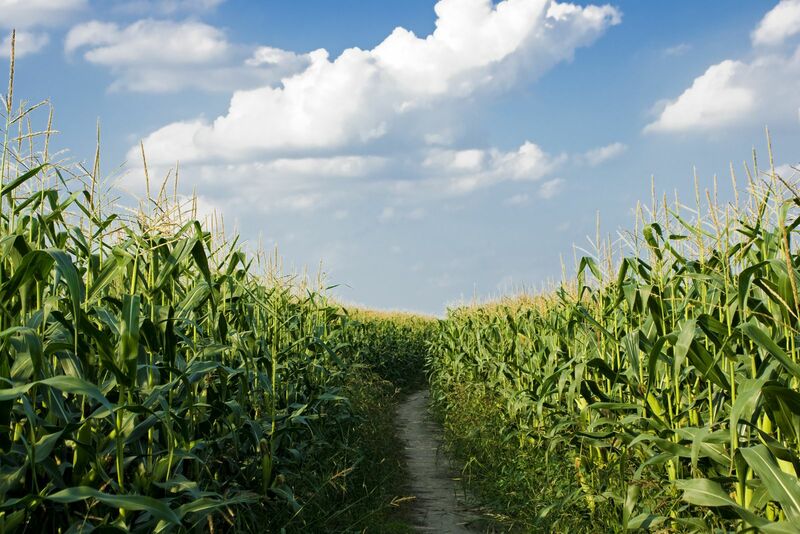
On Friday I joined Michelle Rook on AgWeb's Markets Now. We discussed the recent surge in corn, soybean, and wheat markets. We also talked about the cattle market and boxed beef. Watch my interview here.

Michelle Rook: Welcome to Markets Now. I'm Michelle Rook along with Darin Newsom, Senior Market Analyst with Barchart and we're closing mixed in both grain and livestock futures trade today. Darin, let's start off talking about the wheat market. Of course, we've been rallying here this week and just a little bit higher close today but the funds have been really chasing those Black Sea headlines, haven't they?
Darin: They certainly have. It just depends on how these headlines are being fed into the algorithms. It was a wild day in wheat. At any given time you could see this thing rally or fall 20¢ to 25¢ just, again, depending on what the latest "news" was. It was interesting and I think a lot of it did have to do with algorithm trade. When the dust had settled, the September contract had lost opinion and a half back to the December after gaining 2¢ on Wednesday. Again, it just pushes that spread right back into bearish territory telling us there is no real scare right now, at least short term in global supply and demand.
Michelle: The funds were really short in that Chicago wheat market. Has this been mostly short covering, do you think?
Darin: I think so. If we look at the changes in open interest in the Chicago wheat market, it certainly looks like there's been a lot of short covering in the September contract. Now, the question I had coming into Thursday's session was, looking at the changes on Wednesday, were those short positions being rolled out to December and March, or were those contracts actually seeing new buying interest? It was hard to tell just looking at the numbers. Again, this spread activity would tell us maybe there was some new buying coming in but if so, it certainly seemed to run out of gas about midway through Thursday's session.
Michelle: Yes, because what is your overall take on how this is going to impact global grain supplies or exports on the wheat side of things?
Darin: On the wheat side of things, the world has reshuffled the deck on supply and demand and largely the US was dealt out which really surprises nobody. The longer this situation goes on and the more damage that's done to the ports and the more restrictions that are put on Black Sea shipments of grain as a whole, I do think it does open the door down the road possibly. If that isn't as vague as I can make it, I'll try to make it even more so. If that possibly opens the door to some interest for US supplies at some point, right now we've also got a weaker US dollar, so we'll see how long that lasts.
If the dollar starts to turn, starts to go up, I think it's going to dim some of that possibility of folks getting interested. Right now, long term, I think there is a chance.
Michelle: It's been interesting because there's been a lot more corn that's been exported out of Ukraine than wheat but wheat has been probably the one that's reacted more. The corn market has been trading weather. Today we sat back. Was that profit-taking or hedge pressure? I didn't see a change in the weather forecast.
Darin: Just to quickly finish off the week, yes, non-commercials or funds were still holding a net short of 40,000 contracts as of a week ago Tuesday as reported in the latest CFC report. In the corn market, I do think it was more hedge pressure because this looked to be a gift. Rallying more than 80¢ over the span of four or five sessions unexpectedly at the end of July looking ahead into August when we know we're dealing with more acres, and so far weather has been better than what many had expected. I think this was viewed as a gift. I do think we saw some increased hedge pressure, some increased contracting going on for the 2023 crop.
Michelle: Did we see profit taking in the soybeans as well? We've had a heck of a runoff the lows. I think from the low to the high here recently has been like $3 in the November.
Darin: Yes. It's been an incredible move. That's one where funds were still long. They've been adding to their long position. I do think that as we watch Thursday play out given that it seemed to run out of gas, I would say that was more profit-taking rather than hedge pressure at this point. Again, fundamentally soybeans are quite bullish, at least if we look at the future spreads, we have to wonder about demand not only for this marketing year but next marketing year. I do think as we look at the closes on Thursday, that had more to do with fund profit-taking.
Michelle: Sure. Longer term, do you think that the fundamentals are bullish enough? We're very close to the contract highs again. Are we bullish enough to get pushed over there? Especially if we start to see this yield come down at all?
Darin: If I throw out everything that I think I know about supply and demand weather, acres, and these sorts of things, and I just look at future spreads, it tells me that this market's bullish and it's going to be bullish for a long time, fundamentally. If we start adding some of those things back in, the weather has been better, that might have been the lowest production number we see in soybeans in USDA's July round of numbers. That might have been the lowest figure for 2023 production that we see going forward. Simply, we don't know if there's going to be much demand at all outside of crush demand. I think exports are going to continue to slow down given the amount of supplies that are still available in Brazil. From a future spreads point of view, I'd say it's still fundamentally bullish, but I would put an asterisks with that due to what we, at least, think we know about the market at this point.
Michelle: Got you. Cattle, we were down today despite the fact that we had some 180 cash in the South, which is undoubtedly higher than last week. This has been the fourth reversal that we've seen in live cattle futures here in the last four months we've been fighting these off. Will we continue to fight off these reversals?
Darin: Yes. It goes back to a market that can't go down, won't go down, and that certainly fits live cattle these days. We get these reversals. We see a little bit of pressure, we see some selling coming in, but by the time we get maybe two, three days down the road, it's all gone. It's just simply forgotten. The trend right now is up. We can look at the cash market, we can look at the futures market. Right now, it's just trending up. As long as the trend's up, we need to ride that. We need to ride it as long as we can. We do have to be careful with this thing.
Funds are long, basis is weak, cash market is firming, but it's still well below where the futures markets are sitting. There are some concerns out there. This market could easily get overloaded to the top side, everybody running to the same side of the boat. Usually when that happens, the boat caps sizes or rolls over. We do have to be careful with this market, especially as we look down the road and we've got deferred issues priced in the 190s. That's a really high-priced cattle and I just don't know how sustainable it is.
Michelle: Yes. What are you thinking about demand here? Boxes have obviously trailed off, but usually, seasonally we start to bottom here pretty soon, don't we?
Darin: Yes, that's the big question. How much seasonal pressure do we see on the box beef market because it has broken here in July? We've got a couple of different thoughts on this. Is it an economic indicator that the labor situation, the labor market here in the United States is finally starting to cool a little bit or is it all just a seasonal plan? If so, then we'd look for a month or two down and then we'd start to see the buying come right back in.
For now, we have to trade it both ways. If we want to look at this as a possible economic indicator, it certainly seems to be going against what we're seeing in many of the other markets and many other economic indicators that people talk about. I'd have to probably lean to the seasonal side at this point. The buying season for grilling has come and gone. Now it should cool off for a little bit. The question is, what'll happen to the cash market if boxed beef continues to slide lower? Is that going to provide enough impetus for cash to continue to go higher? I don't know. At some point, packers might simply back out.
Michelle: Yes. They've been trying to cut kills here this week to prop up those cutouts. We'll see how much of that we get in this market. All right. You mentioned the economy. Let's talk about the stock market here because the indices have been hitting highs that we haven't seen this year or even for about a year. Are we going to keep going here, do you think? What does this mean for the ag and commodity sectors in terms of money flow?
Darin: It's a great issue. Something we could probably spend an hour or more talking about, but to me, looking at the long-term charts, we saw all three major stock indexes turned bullish going to long-term uptrends at the end of last October. Most of them, they'd simply been following that pattern. Now, the Dow was the slowest this plotted along for quite a while but it finally seems to be breaking free here in July. What this means for commodities is we've seen a lot of investment money come into commodities and it takes turns going from market to market and then it comes back out.
If the stock indexes are continuing to build long-term bullish uptrends, I think we're going to see that investment money flowing back into stocks, coming out of commodities. Unless there is just some dramatic reason, some dramatic supply and demand situation that says, "Hey, look, we got to invest in this. With the switch from El Nina to El Nino that everyone's talked about, that seems to be less likely that supply and demand isn't going to stay as tight as it was the last few years. Particularly in the grain and oil seed sector, it's just not going to be as an attractive an investment vehicle as what we saw up through say, 2021, '22.
Michelle: The funds have definitely lacked confidence to be in the commodity sector with some of these economic pressures. We'll see if they do come back in. Appreciate you for joining us, Darin Newsom, Senior Market Analyst with Barchart, and that is Markets Now.
On the date of publication, Darin Newsom did not have (either directly or indirectly) positions in any of the securities mentioned in this article. All information and data in this article is solely for informational purposes. For more information please view the Barchart Disclosure Policy here.






